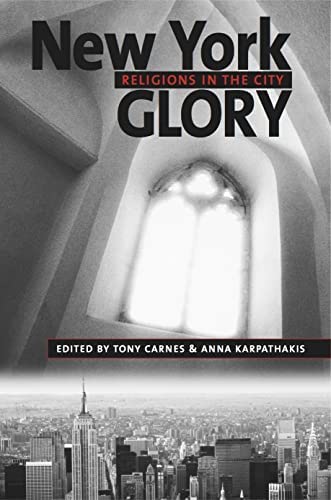Articles/Essays – Volume 35, No. 1
New York Believers | Tony Carnes and Anna Karpathakis, eds., New York Glory: Religions in the City
Church going is not usually one of the primary images associated with New York City, but it seems that “the city-that-never-sleeps” may not be such a godless metropolis after all. New York Glory is an anthology of twenty-five articles that challenges the assumption that New York City is an exception to America’s high levels of religiosity. Most of the contributors are sociologists, anthropologists, or historians; some, like Manhattan lawyer James W. Lucas, who wrote the chapter on Mormons, are religious insiders.
The book’s territory covers all of New York City’s five sprawling boroughs: Manhattan, Brooklyn, Queens, Staten Island and the Bronx. As it turns out, there are more Roman Catholics, Muslims, Hindus, Rastafarians, Jehovah’s Witnesses, Greek Orthodox, Russian Orthodox, and religious Jews in New York City than in any other U.S. city. Church is the fastest growing institution in Hispanic neighborhoods and about 20% of all New York school children are in religious schools. In 1991, 90% of New Yorkers identified with a religious group and believed in God, 82% said that religion was important to their lives, and 46% atended religious services at least once a month.
New York Glory is not a comprehensive survey of religions as they have evolved in New York. It is more a random sampler of some religious cultures in the city and the unique issues they face in its hyper-urban, transient, diverse environment. Rather than being organized along denominational lines, some chapters focus more on ethnic groups (i.e., assimilation in Italian parishes, religious diversity among Latinos, or African-American church leaders) or on religious sub-groups within denominations (i.e., Orthodox Jewish women studying the Torah, religion class at Sing-Sing prison, or therapeutic counseling in “neo-puri tan” evangelical churches). Although the writing is somewhat uneven in quality across chapters and could have benefited from more careful editing, the book is a fascinating romp through this dense religious landscape.
The chapter on Mormons, titled “Mormons in New York City,” is located in the “ethnic diversification” section of the book (along with Islam, which now sports a Spanish-speaking mosque in East Harlem, and Seventh Day Adventism, which claims the highest percentage of immigrants of any denomination). Although hampered in his research by the lack of ethnic data in church records and by the fact that most church statistics are not made public at the stake level, Lucas (co-author of Working Toward Zion) has lived as a Mormon in New York for nearly thirty years. He served on the high council when all five boroughs of the city constituted a single stake (three stakes and two districts now cover the same territory). For his chapter Lucas attended multiple wards and branches in every borough and inter viewed stake, district, and unit leaders, as well as a small cross-section of members.[1]
Written for a non-LDS audience, the chapter contains background on how the church is organized, describes the demographics of Mormons in each borough, and details several salient issues, including economic disparity, gender and leadership, and the high levels of transience among church members in New York City. Perhaps the most interesting contributions Lucas makes for LDS readers concern the issues of retention and ethnic integration. Thus, his chapter is a helpful addition to the literature on Mormonism’s struggles with rapid growth and increasing diversity.
Of the 46 units in New York City in 1998, 21 were Spanish-speaking, two used American Sign Language, and one unit each spoke Chinese and Korean, thus, putting English-speaking units into the minority. Lucas (like many sociologists of religion) argues that social networks are critical to retention and that the large Spanish speaking wards, with their commonality in culture and language, are doing the best job of holding on to their members and keeping them active. The second most successful units in terms of retention are the more diverse English-speaking wards: “when no one ethnic group is dominant, the congregation can develop a culture-neutral ethos that facilitates the adoption of an LDS religious identity and lifestyle” (206). This may be an important lesson to learn for a rapidly expanding multi-cultural church.
Lucas also makes an important point about the long-term retention of ethnic Mormons. He finds that many second-generation Mormon Hispanics prefer to stay in their Spanish-speak ing wards due to family ties or a desire to maintain their heritage, culture, and language. This trend, however, would mean that the church would gradually become more split by ethnic than by linguistic lines—something antithetical to the emphasis church leaders place on unity over diversity (208). Given that abolishing language wards would be seen as insensitive coming from a predominantly white Anglo leadership, Lucas suggests that the best course may be simply to encourage the slow integration into English speaking wards that takes place now, facilitated by the fact that every Spanish-speaking unit shares a building with an English-speaking unit. Al though it is a constant balancing act, Lucas argues that by emphasizing language rather than ethnicity as the line of separation, the LDS church is in a good position to retain second-generation ethnic members, whom other, ethnic-based churches are prone to lose as they assimilate to American society.
New York Glory is a wonderfully eclectic read for anyone fascinated with the many faces of religion in America. The example of Mormonism in New York, which enjoys the same kind of ethnic diversity that Mor monism is projected to have worldwide in five to ten years, may well be a microcosmic proving ground for the church as it learns how to integrate multiple cultures and grow worldwide.
New York Glory: Religions in the City, edited by Tony Carnes and Anna Karpathakis (New York City: New York University Press, 2001), 440 pp.
[1] Telephone interview with James W. Lucas, October 13, 2001.


 Back to full Issue
Back to full Issue

